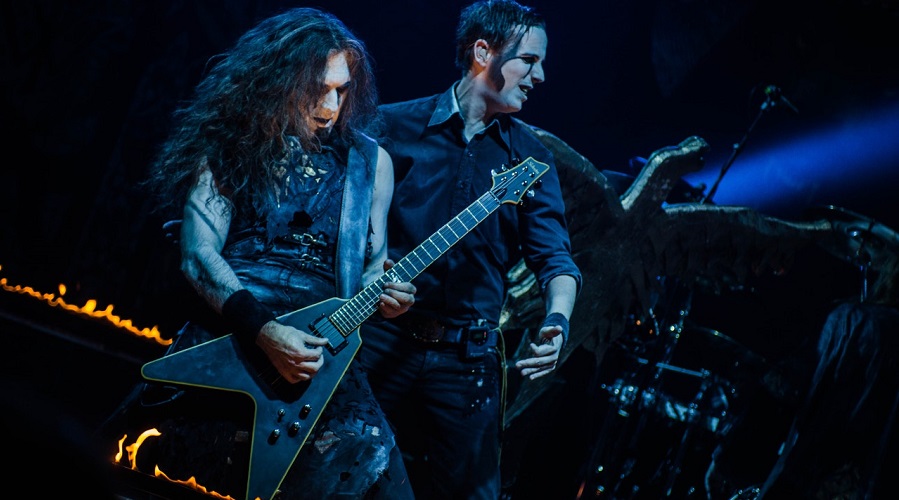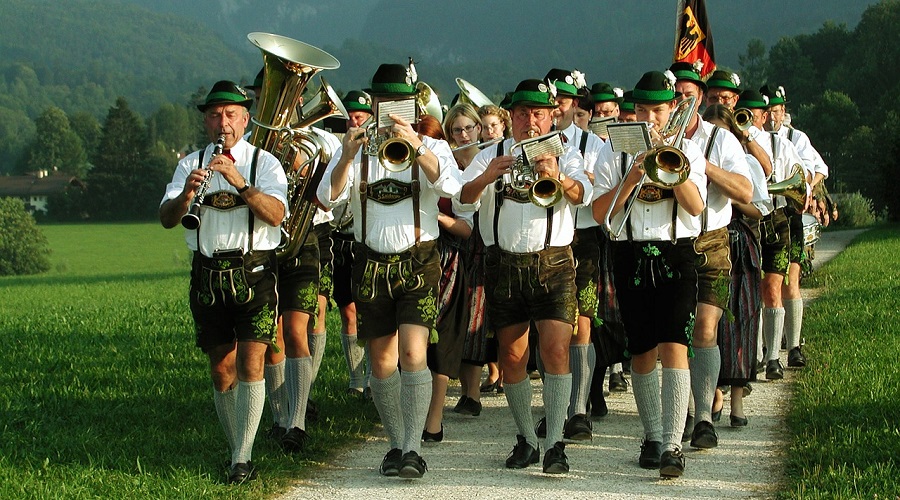Hard rock, cacophonic loops, and abrasive vocals—these are the words that first come to mind at the mention of industrial music. It’s an anti-establishment genre that peaked in the mid-90s, known for its aggressive fusion of electronic music and rock.
This post discusses everything you need to know about industrial music. What is industrial music, and what is its importance in the world of rock and EDM? Let’s find out.
What Is Industrial Music?
Industrial music is a music genre characterized by a blend of avant-garde electronic music, hard-synth sounds, and punk provocation. It’s mostly associated with improvisation, experimentation, and aggressive noise.
Notable industrial music bands include Nine Inch Nails, Rammstein, and Ministry, all of which received platinum-selling albums in the 1990s.
History of Industrial Music
Members of Throbbing Gristle and Monte Cazazza coined the term “industrial music” with the founding of Industrial Records in the mid-1970s.
Even so, the genre’s history extends all the way back to the experimental electronic musique concréte movement led by Pierre Henry and Pierre Schaeffer, two of the most prolific French composers in the 1920s, ‘30s, and ‘40s.
In Igor Stravinsky’s 1930 Kultur und Schallplatte, the Russian-born composer predicted the rise of industrial music with the quote, “there will be a greater interest in creating music in a way that will be peculiar to the gramophone record.”
Several years later, in 1942, The Musical Quarterly dubbed Dmitri Shostakovich’s 1927 Symphony No. 2 “the high tide of ‘industrial music,” thus sparking interest in the creation of acousmatic sound.
With that said, industrial music only began making a name for itself at the beginning of the 1970s. At the time, industrial artists believed that punk’s revolution would only be realized by severing its roots with traditional rock.
Monte Cazazza, one of London-based Industrial Records artists, suggested the slogan Industrial Music for Industrial People, thus creating a new genre.
Industrial bands began experimenting and deploying noise, hypnotic machine rhythms, electronics, and tape loops into their music. They then paired it with aesthetically controversial topics like sexual perversion, fascism, and the occult.
Importance of Industrial Music to Modern Society

Although associated with rage and provocative language, industrial music isn’t only created to offend. It’s born to challenge preconceptions of musical rules created by modernist musicians.
Initially, industrial artists purposely used disturbing lyrics and sound as a commentary on modern society. By using taboo-breaking, provoking elements and totalitarian imagery, industrial music sheds light on the unequal distribution of power in society.
Similar to punk music, industrial music—or “anti-music” as some had called it—is aimed towards the working class and those who stand in opposition to the conventional principles of a society, whether it be of social, economic, or political standing.
In other words, industrial music is created to open people’s minds about the harsh realities of the world and how much destruction individuals can cause against their fellow man.
Industrial Music Today
Industrial music is still going strong to this day, with millions of dedicated fans. The genre is currently represented by post-industrial artists like Sally Dige and Factory Floor, both of which incorporated accessible melodies and beats into their songs.
Another notable band in the industrial music genre is 3TEETH, an American industrial metal band formed in 2013. Some of their popular albums include REMIXED (2014), Lights Out/Time’s Up (2018), and Guns Akimbo (2020).
Types of Industrial Music
There are over 10 different subgenres of industrial music, but all of them share the exact same thing: chaotic, dissonant electronics that build up into rather intense and jarring textures.
As follows are some of the most popular subtypes of industrial music today:
Dark Ambient

Dark ambient, also known as ambient industrial, is a subgenre of industrial music characterized by ominous, gloomy droning, and catacomb-like atmospheres with inharmonious overtones.
The term ‘dark ambient’ was first conceived by Roger Karmanik in the 1990s as a means to describe the music of Peter Andersson’s raison d’être and other artists associated with the record label Cold Meat Industry.
The roots of dark ambient go as far back as the 1970s, a time where synthesizers, sampling technology, and effects units were smaller and more affordable.
One of the earliest known elements of dark ambient can be found on Throbbing Gristle’s 1978 album D.o.A: The Third and Final Report of Throbbing Gristle.
It can also be found in the soundtrack of David Lynch’s 1977 film Eraserhead and Tangerine Dream’s 1972 early double-album Zeit.
Electronic Body Music
Electronic Body Music (EBM) is a genre of electronic and industrial music that consists of programmed dance music rhythms, repetitive basslines, and undistorted vocals with command-like shouts and offensive themes and lyrics.
The term Electronic Body Music was coined by Ralf Hütter of Kraftwerk in 1977 during his interview with WSKU radio. But it only became popular in the 1980s with the rise of the industrial music scene. EBM emerged in the youth-cultural scene in the late 1980s.
Examples of EBM artists include Spetsnaz., Ionic Vision, and Tyske Ludder.
Electro-Industrial
Electro-industrial shares a lot of its elements from Electronic Body Music (EBM) except for one thing: structure.
While EBM tends to have a cleaner, more minimal structure, electro-Industrial is gritty, complex, and experimental.
Pioneered by Skinny Puppy, Numb, and Front Line Assembly, electro-industrial attained its popularity in the international club scene.
True to the industrial music scene, electro-industrial uses harsh and raspy beats and usually paired them with distorted or digitized vocals.
Apart from the three bands listed above, prominent electro-industrial bands of the 1990s include Due Form, Borghesia, SPK, and Klinik.
Industrial Hip-Hop

As the name suggests, industrial hip-hop, also known as Noise Rap, is a fusion between industrial music, hardcore hip-hop, and dub music. It was first developed in the early 1980s through the works of Bill Laswell, Mark Stewart, and Adrian Sherwood.
Industrial hip-hop generally features blaring, distorted drums, and dissonant atonal noise.
Similar to most industrial music subgenres, the vocals are aggressive and loud. The lyrical content is usually offensive, disturbing, and/or confrontational, with subject matters such as war, sexual abuse, sexual perversion, BDSM, cults, etc.
Artists such as Techno Animal, Dälek, and Saul Williams are some of the most notable artists in the industrial hip-hop genre. Their early albums described some of the most disturbing occurrences of underground hip-hop, shedding light on the unconventional practices at the time.
Industrial Rock
Industrial rock uses elements of industrial music and rock music. It originated in the early 1970s from experimental bands and acts such as Throbbing Gristle, Cromagon, Chrome, and Einstürzende Neubauten, amidst disco fever and punk rock revolution.
It was populated in the 80s by artists such as Skinny Puppy, Killing Joke, and Swans. Later, in the 90s, by Marilyn Manson and Nine Inch Nails.
Industrial rock uses heavily distorted guitars, bass guitars, and drums that are sometimes replaced by electronic music. Like most industrial music genres, industrial rock subject matters include provocative and transgressive topics.
Power Electronics
Power electronics consists of screeching waves of feedback, loud static, high-frequency squealing sounds, sub-pass pulses from analog synthesizers, and screamed, distorted lyrics, which are usually hateful and offensive.
This music genre is deeply atonal, meaning it doesn’t contain any conventional melodies or rhythms.
Power electronics was coined by William Bennett in his liner notes to Whitehouse’s seventh album Psychopathia Sexualis. Other famous artists include Genocide Organ, Ramleh, and Brighter Death Now.
Japanoise

Japanoise, a combination of “Japanese” and “Noise”, is a subgenre of industrial music in Japan. It was most popular in the 1980s and throughout most of the early 21st century.
This industrial subgenre was revered because of its sense of musical freedom. Inspired by power electronics, Japanoise usually deals with themes of BDSM, sexual violence, and war.
Japanoise music is usually characterized by overwhelming dynamic shifts, aggressive dissonance, electronics, and extremity. Groups such as Hanatarash, Incapacitants, and Merzbow are some of the most popular Japanoise bands not only in Japan but across the world.
Neofolk
Neofolk, also referred to as apocalyptic folk, is a combination of folk experimental music and industrial music. It’s believed to have emerged from punk rock circles in the 1980s and popularized by musicians Douglas Pearce, Tony Wakeford, and David Tibet.
Neofolk music often touches upon literary, archaic, and cultural references.
Modern and original neofolk artists play themes of neopaganism, heathenry, romanticism, and occultism in their songs. They also use fascist symbolism, slogans, and ideas from the book The Forest Passage (Waldgäng) by Ernst Jünger.
Witch House
Witch house is part of the electronic music microgenre and the industrial music subgenre. It’s characterized by dark, occult-like themes that are transgressive and provocative in nature. It also features heavily altered and almost ethereal-like vocals.
This genre’s visual aesthetics include witchcraft, occult, shamanism, terror, and horror-inspired artworks. Photographs and collages with hidden messages and typographic elements are also used.
American electronic musician Travis Egedy, also known as Pictureplane, coined “witch house” in 2009 as a joke, but took off when mainstream music press began to use the term to describe occult-like music.







